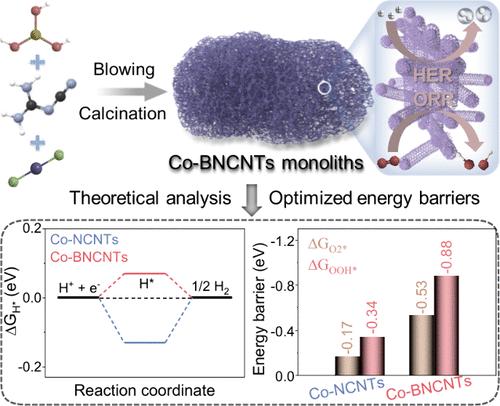揭示硼载体对三维析氢和氧还原反应催化剂几何和电子结构调控的重要影响
IF 9.1
1区 材料科学
Q1 CHEMISTRY, MULTIDISCIPLINARY
引用次数: 0
摘要
深入了解催化剂的结构性能关系近来受到重视。然而,由于催化剂的结构多样而复杂,尤其是支撑材料的影响容易被忽视,因此这仍然是一项挑战。在此,我们通过一种有趣的化学吹气辅助煅烧方法,揭示了硼的引入对合成内嵌多态 Co 金属(即单原子、团簇和纳米颗粒)的三维碳纳米管单体的重要影响。硼的引入有助于形成迷人的硼氮对、塑造三维框架和调节电子结构。三维 Co-BNCNT 单片在所有 pH 值的氢进化反应(HER)和氧还原反应(ORR)中都表现出良好的催化性能。理论计算表明,在 Co-NNCNT 中掺入 B 可以优化吸附氢的自由能,促进 O2 的吸附和 O2* 物种的质子化。此外,基于 Co-BNCNTs 的锌-空气电池具有高功率密度和放电-充电耐久性等优异的电池性能。本文章由计算机程序翻译,如有差异,请以英文原文为准。

Revealing Crucial Influences of Boron Support on Regulating Geometric and Electronic Structures of 3D Catalyst for Hydrogen Evolution and Oxygen Reduction Reactions
Building insights into the structure–performance relationship of catalysts has been emphasized recently. However, it remains a challenge due to catalysts’ various and complex structures, especially the easily overlooked influence of the support material. Here, we reveal the crucial influences of boron introduction on synthesizing 3D carbon nanotube monoliths with embedded multistate Co metals, i.e., single atoms, clusters, and nanoparticles (Co-BNCNTs), by an interesting chemical blowing-assisted calcination method. The boron introduction can contribute to forming captivating boron–nitrogen pairs, shaping a 3D frame, and regulating electronic structure. The 3D Co-BNCNT monoliths present good catalytic performance for both the hydrogen evolution reaction (HER) at all pH values and the oxygen reduction reaction (ORR). The theoretical calculations indicate that the B incorporation in Co-NCNTs can optimize the free energy of adsorbed hydrogen and facilitate the O2 adsorption and the protonation of the O2* species. Furthermore, the Co-BNCNTs-based zinc–air battery provides great battery performance with a high power density and discharge–charge durability.
求助全文
通过发布文献求助,成功后即可免费获取论文全文。
去求助
来源期刊

Nano Letters
工程技术-材料科学:综合
CiteScore
16.80
自引率
2.80%
发文量
1182
审稿时长
1.4 months
期刊介绍:
Nano Letters serves as a dynamic platform for promptly disseminating original results in fundamental, applied, and emerging research across all facets of nanoscience and nanotechnology. A pivotal criterion for inclusion within Nano Letters is the convergence of at least two different areas or disciplines, ensuring a rich interdisciplinary scope. The journal is dedicated to fostering exploration in diverse areas, including:
- Experimental and theoretical findings on physical, chemical, and biological phenomena at the nanoscale
- Synthesis, characterization, and processing of organic, inorganic, polymer, and hybrid nanomaterials through physical, chemical, and biological methodologies
- Modeling and simulation of synthetic, assembly, and interaction processes
- Realization of integrated nanostructures and nano-engineered devices exhibiting advanced performance
- Applications of nanoscale materials in living and environmental systems
Nano Letters is committed to advancing and showcasing groundbreaking research that intersects various domains, fostering innovation and collaboration in the ever-evolving field of nanoscience and nanotechnology.
 求助内容:
求助内容: 应助结果提醒方式:
应助结果提醒方式:


